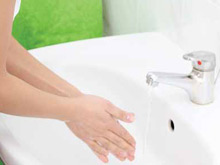Health Topics
-
Healthy Living
-
|
|
April 2012
|
| The Right Way To Wash Your Hands |
| Dr Lavanya Nutankalva |
| |
 |
The skin is the largest organ in the human body and has a surface area of about 1.5 to 2.0 square metres. It is the first defence against organisms that can cause diseases ranging from common cold to other serious infections. |
Any cuts or lesions of the skin are possible areas of entry for bacteria and viruses. If you are a healthcare person or someone who is taking care of a sick person, your hands are also the most likely route through which infections or microorganisms might spread between patients or other members of the family. So, simply washing your hands is the most effective method of preventing the transmission of infections.
Some of these bacteria and viruses can survive on the surfaces from days to weeks! So, don’t underestimate the power of hand washing. The few seconds you spend at the sink could save you trips to the doctor’s office
Germs Travel Path
- Dirty hands
- Changing dirty diapers
- Contaminated water and food
- Droplets released during a cough or a sneeze
- Contaminated surfaces
- Contact with a sick person’s body fluids
House rules for hand washing to minimize the germs passing around in your family
- Before eating and cooking
- After using the bathroom
- After cleaning around the house
- After touching animals
- Before and after visiting or taking care of any sick friends or relatives
- After blowing one’s nose, coughing, or sneezing
- After being outside (playing, gardening, walking the dog, etc.)
What To Use?
- Soap and water – the best way to reduce the number of germs on the hands.
- Alcohol-based hand sanitizer that contains at least 60 per cent alcohol. (Sanitizers do not eliminate all types of germs. Hand sanitizers are not effective when hands are visibly dirty.)
|
 |
Dr Lavanya Nutankalva is Consultant- Infectious Diseases, Apollo Health City, Hyderabad |
|
|